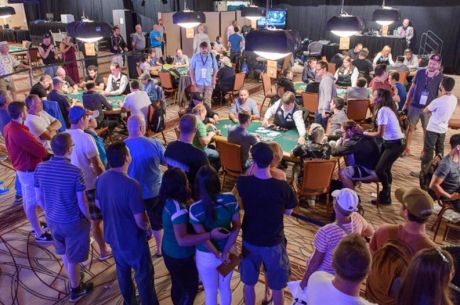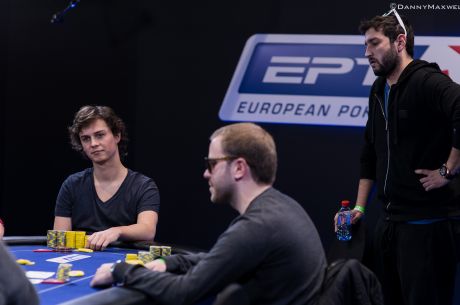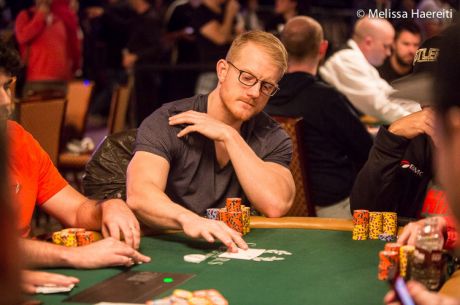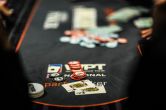How I Survived the World Series of Poker Main Event Bubble
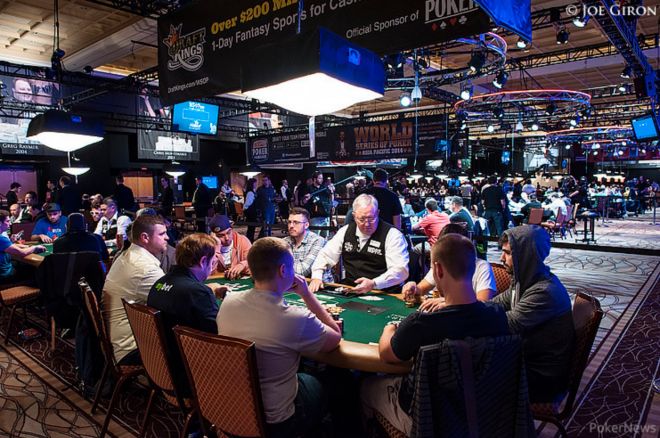
Introduction
I��m a small-stakes tournament grinder who came to Las Vegas this year with the intention of playing $400 tournaments at Planet Hollywood all summer. For some odd reason, my friends talked me into selling action and playing the World Series of Poker Main Event.
On Day 1, my big blind was constantly abused by well known poker pro Phil Laak. Somehow, I even survived a set-over-set situation in a three-bet pot against him.
On Days 2 and 3, I faced more aggressive pros whom I did not know by name or face. I managed to survive encounters with them as well.
After my third dinner break, I found myself on the bubble of the world��s premier poker tournament. This was the biggest bubble I��d ever faced. If there were ever a situation where I should prioritize getting the cash over getting the chips, this was it. I wasn��t even supposed to make it this far. Given that I did, I decided that I should do everything in my power to at least cash the damn thing.
Here��s how I did it.
1. Know The Median Stack
If you look at the tournament clock, one of the pieces of information it provides is the average stack. In a tournament like the Main Event, where there is so much variation between the biggest stacks and the smallest ones, this information is almost useless. I needed to know how much the player in the middle of the pack had. This statistic, known as the median, would help me determine roughly how many people had fewer chips than I did.
I asked my buddy Russ to calculate this number for me. The start-of-day list showed that with 1,796 players starting the day, the 898th- and 899th-place stacks in the middle had around 92,000. Meanwhile the average at the time was about 107,000. This was a difference of about 10 big blinds!
The bigger the average stack is relative the median stack, the more short stacks there are. With much more than half of the median, I figured to be in good shape to squeak into the money considering that there were probably many people as short as a quarter of the median.
2. Know The Cost Per Orbit and Time Per Orbit
Going into the dinner break, I had 48,000 coming back to 1,500/3,000 with a 500 ante. My friend and fellow short stack Nate Meyvis figured that the bubble would last for about two more orbits as we were 51 eliminations away from that magic number of 1,000 �� i.e., the number of places paid.
We figured that at a nine-handed table, a complete orbit would cost 9,000 chips and roughly 20 minutes. If all of our assumptions were correct, I could fold for 40 minutes and still have 30,000, or 10 big blinds, to take into the money.
Given that a little over 15% of the field would be paid and that the bottom third of the cashers (352 players) would all be paid the same $15,000 for a minimum cash, making the money seemed like a good priority to set. Besides, the additional pay jumps were relatively small until the tournament got down to 100 players. I wouldn��t have an opportunity for another $15K pay jump unless I made it to 72rd place! This was very unlikely considering that I never crossed the 100,000-chip mark the entire tournament.
3. Don��t Induce Action
Being the rookie that I am, I was content with that plan. So imagine my dilemma when I suddenly picked up KxKx in early position with about 15 big blinds and approximately 20 players to go before the money bubble had burst.
I had a sure-fire plan to cash which was my goal at this point. A less risk-adverse player would likely min-raise this hand hoping to induce a call or three-bet from AxXx or smaller pairs. Instead, I just decided to shove. Maybe it makes sense to take a 20%-30% chance at bubbling for some, but for me it made more sense to shove in order to maximize my fold equity and likely lock up a cash in my first Main Event.
4. Don��t Be a Hero
Once I got the shove through, the better players at the table knew I had enough chips to wait it out. They used this knowledge to attack my big blind with almost any two cards. In normal circumstances, when players are opening with wide ranges, you can defend your big blind with a wide range, especially with the pot odds you are being offered. I tend to defend with any two suited cards and most cards that can make a straight.
On the bubble of the Main Event, however, I decided not to fight back that wide against these aggressive blind-stealers. I knew they likely had absolute crap, but I was not in a position to be a hero and teach them a lesson. Had I defended, they were all capable of putting tremendous pressure on me postflop and getting me off a ton of marginal hands.
5. No Shame in Stalling
The bubble lasted a little longer than I expected. This caused me to panic. I noticed that the shorter stacks around me were starting to stall. They would tank on every hand when they clearly had no intentions other than folding. I have been trained not to do this in all but the most extreme circumstances. I told a group of much better players than I that I would not stall, but I was glad that the others were doing so.
They instantly told me that stalling made perfect sense on a bubble like this. They said it��s unfortunate that so many people choose to stall, and perhaps even the structure of the event incentivizes it. Like it or not, many others were doing it, and if I didn��t also do it, I would be at a disadvantage as a short stack. With their permission, I started to take a few more seconds before each fold and became that fake tank guy that I love to hate. It felt dirty, but the bundles of $15K in new money I received smelled oh so fresh and so clean.
Conclusion
Not long after the bubble burst, I picked up 7x7x in the big blind and shoved my short stack over an aggressive opener who has a reputation as a slow roller. She asked for a count and after some deliberation, finally decided to send me packing with AxAx.
This didn��t bother me at all. For me, walking away with a cash in the Main Event felt like a win. And I could not have done it without my friends playing poker caddy for me and giving me permission to be the nit that I naturally am.
Get all the latest PokerNews updates on your social media outlets. Follow us on Twitter and find us on both Facebook and Google+!

